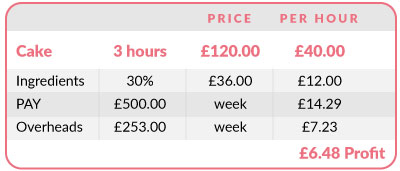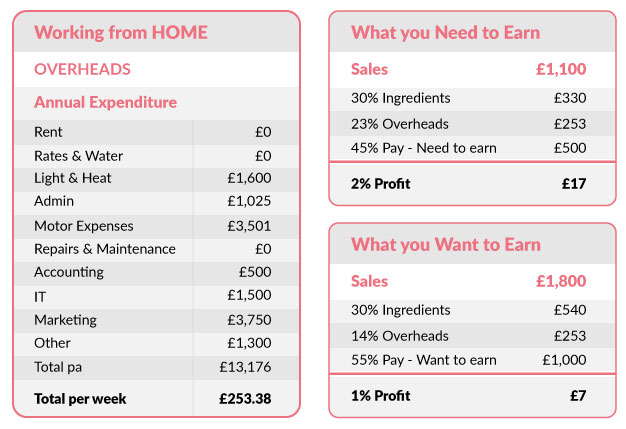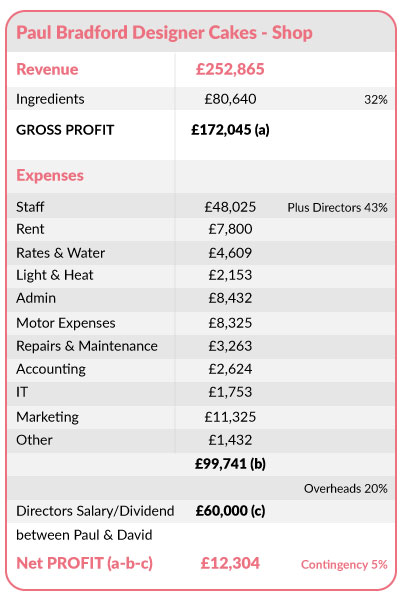No doubt many of you have thought about it? But just what can you expect to earn making cakes? This guide alongside our live tutorial will cover all you need to know about how to make sensible profit out of your passion turned profession.
Six key points that will determine what you will earn:
- Your ability to grasp the business side of making cakes

- Knowing what you need to charge to meet your target income
- The ability to apply those prices to your business
- Removing the limiting belief; ‘but nobody will pay that in my area’
- Marketing – online and offline
- Product – your cakes
It is important to note that the quality of the cakes themselves sits at number six. Many cake decorators spend so much time, effort and money on their cake skills and creating their products but so little on addressing the points above.
Pricing Cakes – What do you need to charge?
In order to work out what you NEED to charge to make your cake business profitable, first you need to pour a coffee and answer the following key questions as accurately as you possibly can:
- How much do you NEED to earn a week to survive?

- How many cake decorating hours can you give every week?
- How many cakes can you make within those hours?
- What are your weekly overheads?
- What are your Cost of Ingredients?
Taking points 2 and 3, it makes things easier if you look at each cake and allocate a number of hours to decorate. That way you can ensure that whether its a quick and easy cake or 7 tier masterpiece, that your pricing is consistent and you know that it will be profitable.
The numbers given below are to provide some content to the formula, but your number will likely vary hugely;
- How much do you NEED to earn to survive? £500 (currency converter at the foot of the page)
- How many cake decorating hours can you give every week? 35
- How many cakes can you make within those hours? see above for how to better breakdown those hours
- What are your weekly overheads? £253 (see overheads table below)
- What are your Cost of Ingredients? 30% of the price of the cake
Pricing based on a 35 hour Decorating WeekTo give a cake decorating hour a value; say a cake at £120 takes 3 hours of your 35 hour week.

The two main components when it comes to pricing cakes are ingredients and time (your pay) so you need to develop a pricing chart that assesses both.
Our Pricing Chart would have Bands as the column headers, which were time orientated and the cake size, which are ingredient cost orientated, as the rows. When you produce your pricing chart it shows the customer very clearly what they are paying for and you’ll know that you are pricing for profit.
Professional v Hobbyist
Everyone has different financial requirements. While a professional and hobbyist can produce the same level of cake, the main issue comes down to what they require in terms of income.
Hobbyists are not making cakes to earn a living, they are making cakes because they enjoy it and will only charge a minimal amount, perhaps to cover ingredients. The hobbyist then gets their reward through the gratitude of the recipient.
Professional cake decorators will, however, require an income from their business. Using the formula above will help determine what that income is, how many cakes are needed and the prices required to achieve those results.
Hobbyists do not need to make a contribution to business running costs, nor need to charge for their time. This is where the huge discrepancy comes when comparing prices between professionals and hobbyists.
Professionals feel that this is unfair and creates an uneven playing field. Hobbyists wonder what all the fuss is about as they will charge what they want to charge. There’s no point in one side or the other getting annoyed by this, as that will only lead to a negative spiral and never change the underlying facts.
Professionals need to set their brand, marketing and customer experience above the hobbyist and target customers who will pay the professional prices for a professional service.
What can you expect to earn?
This is a challenging question and one that comes with many caveats.
The best way to assess your viability is to create an Excel spreadsheet and calculate your weekly costs with the following headings:
- Sales – leave this field blank until the end
- Ingredients – you need to know your % ingredient costs. If you don’t, 30% would be a good place to start so enter as a % of sales
- Overheads – you absolutely need to know your overheads. This value will be fixed regardless of sales
- Pay – this value will be fixed to start with and changeable as you play with the numbers
- Profit – so long as this is a positive number adapt the sales number to get your break-even figure
Working from Home
Using the table and formulas suggested above, here is an example of the sales required in order to achieve the NEED to earn figure of £500 per week:

In these examples, sales need to be sitting somewhere between £1,000 and £1,800 per week. But remember, if you are a sole trader, any holidays etc mean that you can’t be earning those weeks and need to think about dividing the overheads by the number of weeks you plan to work.Using the same table, here is an example of the sales required in order to achieve your WANT to earn figure of £1000 per week:
If you have 35 decorating hours, assuming that your ingredients are around 30% of the price you charge then you should be charging somewhere between £31 – £51 per hour as a gross sale price.
That means that a cake taking 5 hours needs to be charged between £155 and £255.
This will result in a salary of between £26,000 to £52,000.
Profit from Running a Shop
Here is an extract of account from Paul Bradford Designer Cakes, which was run from a shop on Linlithgow High Street in 2005. Note that this was before Paul was known and we had 4 members of staff, we were also selling balloons and other party accessories:

This is just an example, which provided two Directors salaries / dividends of £30,000 each.
Leverage Points
If you aren’t or feel you can’t charge these prices then you need to look at the levers at your disposal to make profit without increasing your prices.
- Reduce your overheads
- Reduce your cost of ingredients
- Reduce your pay
I’ll bet none of them feel that comfortable either? Which is why putting your prices up makes so much sense.
Watch the LIVE presentation of this blog with David and Paul on CakeFlix TV
For more information on this and for effective marketing techniques along with invaluable, straight talking, business information check out our BUSINESS TUTORIALS delivered by Paul Bradford & David Brice along with professionals in Digital Marketing, Business Coaching, Photography and in the Legal and Accounting fields.
Sign up for CakeFlix today to access over 850 multi-award winning cake tutorials including exclusive courses on how to run a successful cake business.

